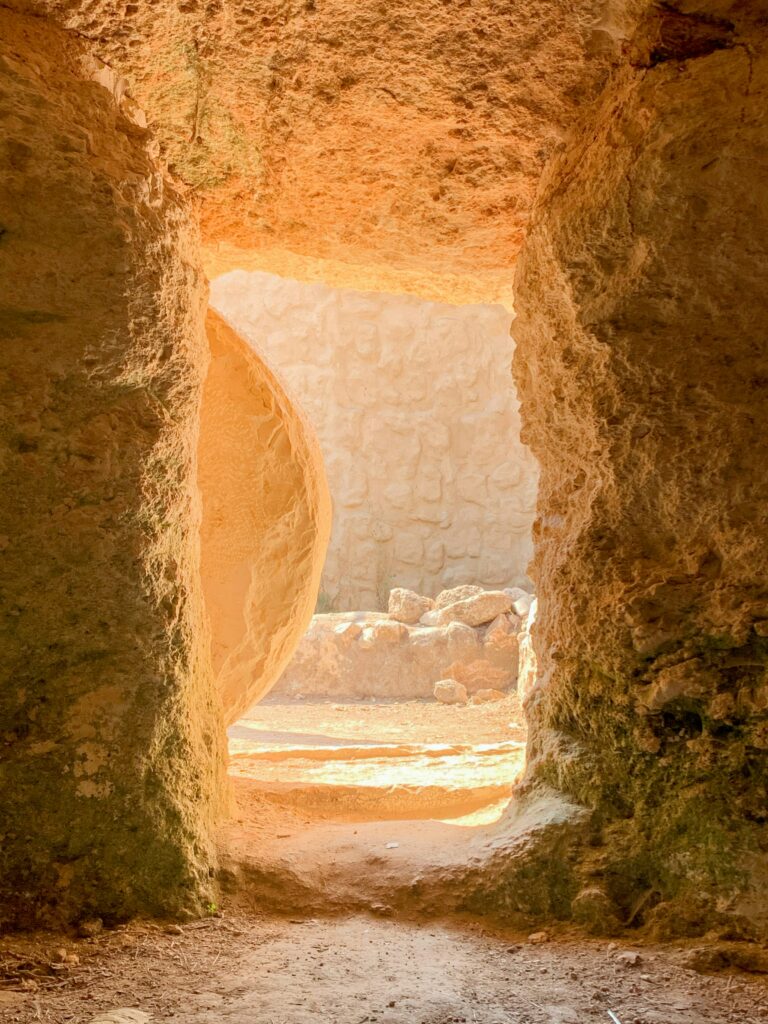“Once you eliminate the impossible, whatever remains, no matter how improbable, must be the truth.”
Sherlock Homes (Arthur Conan Doyle)
“For I delivered to you as of first importance what I also received, that Christ died for our sins according to the Scriptures, and that He was buried, and that He was raised on the third day according to the Scriptures, and that He appeared to Cephas, then to the twelve. After that He appeared to more than five hundred brethren at one time, most of whom remain until now, but some have fallen asleep; then He appeared to James, then to all the apostles; and last of all, as to one untimely born, He appeared to me also.”
The Apostle Paul (1 Corinthians 15:3)
Jesus died…was buried…was raised…appeared in person to many people. That is the solid story of the New Testament, told in all four Gospels (Matthew 27-28, Mark 15-16, Luke 23-24, and John 19-20) and repeated with emphasis throughout the remainder of the writings (Acts 2:22-24, Acts 2:32, Acts 3:14-15). Such an improbable assertion requires extraordinary proof; the Bible provides it. Let’s take it in those steps…
Died
Today we wear our cross necklaces and toss around the word “crucifixion” far too lightly. In reality, it was a cruel, slow death by asphyxiation. The victim was held to the wooden cross in such a way that, as they tired and their body sagged, they were unable to draw a breath. At first, they could try to push up against the spikes through their feet to relieve the downward pressure on the diaphragm. Eventually, they no longer had the strength to do so, and they suffocated. 1
Prior to the crucifixion, Jesus was scourged. Far beyond “just a whipping”, this was flaying the back with a whip of multiple cords with pieces of metal knotted into the ends. 2 People had a bad habit of dying from the scourging alone, although the Romans tried to keep them (barely) alive long enough for the actual execution.
The Roman executioners were asked to hasten the deaths of Jesus and the other two crucified at the same time, so that the bodies could be removed before the Sabbath holy day. The standard means was to break the victims’ legs, making them unable to raise up to get breath. In Jesus’ case, that was not necessary, because He was already dead. However, making absolutely certain, one of the Roman soldiers stabbed his spear into Jesus’ side. His friend John reported that “immediately blood and water came out” (John 19:32-35), probably indicating that the heart and its pericardial sac had been pierced.
There are those who say “Maybe he didn’t die. Maybe he just passed out.” Really? Keep reading….
Was Buried
The Gospels record that a follower named Joseph of Arimathea was given permission to bury Jesus’ body. (The alternative was the body being dumped into a common grave, or left for carrion to destroy.) All four Gospels say that the burial place was a new (not yet used) tomb carved out and sealed by a stone across the entrance. Matthew says that it was Joseph’s own planned tomb (Matthew 27:59-60). Matthew also records that a guard was posted at the tomb to prevent any disturbance (Matthew 27:62-66).
There are those who say “Maybe he came back to consciousness in the nice cool [unsanitary, no medical attention, no food or water, sealed and guarded] tomb”. Really? Keep reading…
Was Raised
All four Gospels record the women going to the tomb at first light as soon as the Sabbath was ended. They were planning to prepare the body with spices as was customary for funerals. (Apparently, they didn’t trust that the men had done a good enough job in the rush just before Sabbath started!) Mark records that the women were concerned about access to the body: Who would move the heavy sealing stone for them? (Mark 16:3) All four Gospels say that wasn’t a problem: The stone was already moved when the women arrived, and the tomb was empty. (Matthew 28:2, Mark 16:4, Luke 24:2-3, John 20:1) All four Gospels record men in dazzling white clothing (angels) giving the women the news that “He is not here, but He has risen.” (Matthew 28:6, Mark 16:6, Luke 24:5-6). Well, that’s not quite true: John reports that Mary Magdelene saw the angels. But they weren’t the ones who told her Jesus was risen. He proved that to her himself! (John 20:14-18)
It is significant that the Gospels are unanimous that women were the first to find the empty tomb. In that culture, women couldn’t even testify in court; their word was not considered trustworthy. If the four men writing down the story had been making it up, Mary Magdalene and the other women are the last people they would cast in the lead roles.
To those who quibble about the exact timing, number and position of the angels, identities of the women: That’s what happens when four eyewitnesses tell the story of an event that happened to multiple people over some amount of time. Daylight changes; people move around. That’s real life. If their stories had been exactly identical, it would be evidence that they collaborated to get their lies straight!
There are those who say “Maybe the women went to the wrong tomb, or the body had been moved.” Really? Keep reading…
Appeared in Person
Mary Magdalene was the first person to see Jesus, there at the empty tomb. This was no “Elvis at the 7-Eleven” sighting, either. Apparently, she hugged Him as though she would never let go. His phrasing was “Stop clinging to me” (John 20:17-18)
Later that evening of Resurrection Day, the rest of the Jesus’ followers got their first chance to see Him. They were in a room with the door shut, hiding from the rulers who had killed Jesus, afraid that they would be next. They stopped being afraid when Jesus stood among them and showed them the wounds in His hands and side (John 20:19b-20). Thomas (“Doubting Thomas”) missed that party, and didn’t believe the others’ story. He said he wouldn’t believe until he saw for himself. A week later, he did! (John 20:24-28) We can be grateful to him for expressing the doubt, so that it could be resolved for us.
Other visits with the risen Jesus are recorded, such as on the road to Emmaus (Luke 24:13-33), sharing breakfast on the seashore (John 21:1-14), and teaching over a 40-day span before He ascended to Heaven (Acts 1:3, Acts 1:7-11). Others are referred to, like the “more than five hundred brethren at one time” from Paul’s letter to the church at Corinth, quoted at the beginning of this article.
There are those who say “Maybe it was mistaken identity, or wishful thinking, or hallucination” or “Maybe the disciples stole the body so they could say He had risen”. Really? Keep reading….
So, what remains?
The same followers who were hiding from the authorities one day, were suddenly telling those same authorities “we cannot stop speaking about what we have seen and heard” (Acts 4:18-20). Church tradition is that ten of the original twelve disciples went to their deaths insisting that He was the risen Savior (and an eleventh was exiled until his death, while the twelfth was Judas the betrayer). In fact, they went to their deaths because they insisted on that fact.
- Could this be caused by a not-quite-dead Jesus stolen from the tomb (past the guards) and nursed back to health, without the aid of a major trauma center, by the disciples hiding in fear for their own lives? People may give their lives because of a lie that they believe; they don’t because of a lie that they themselves told!
- Also, if such a thing were so, what happened afterward? Where was he while his people were claiming that He was risen from the dead, changing the world with the claim that He is God and Saviour, and dying for that claim? Where and how did he live? When did he die (again) and where was he buried (again)?
- Both Jewish and Roman authorities had interest in Jesus being dead, and plenty of power to stop this new little band of followers. All they had to do was produce the body, either from the right tomb or by hounding it out of the disciples. Crickets…
- Elvis was not seen at the 7-Eleven up close and personal, for extended lengths of time, by multiple people at once, who knew him well. Jesus was (although not at a 7-Eleven!). Also note that they saw Him healthy, not limping through recovery from horrific trauma.
What is left? How about that Jesus really did die, really was buried, really did rise, and really was seen? Remember, any alternate explanation has to account for all of this evidence. No fair picking and choosing some points and ignoring others!
What’s left after the impossible is eliminated is: Jesus really is God, and really is alive right now. His death was in sacrifice to provide for my reconciliation with God, and His resurrection proves that it was successful (Ephesians 1:20, Romans 4:24b-25).
For further study, I highly recommend any of Lee Strobel’s books. Especially, I recommend starting with “The Case for Christ“, his record of how, as an atheist, he investigated to disprove the Resurrection. His plan backfired, and he became a Christian due to the evidence he gathered.
For lighter reading, I have a little fictional story on this site describing the Resurrection from the perspective of the stone that sealed the tomb. It’s not “Biblical”, but it was fun for me to write.

